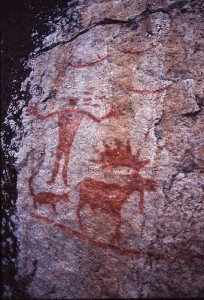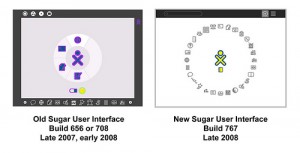Icon to Symbol: Its Implications on Visual Literacy and Education
For a more visually appealing wiki post, please continue to the ETEC 540 wiki.

Early Pictographic Communication: Pictographic art from Minnesota shows how Native Americans communicated with one another (jacehgn, 2009).
Icons and symbols are everywhere. Throughout history, icons and symbols have a vital role as a communication tool. In their most simplified forms, they are recognizable and often, comprehensible images and visuals; in their most complex forms, they exist as a series of abstract lines to complex strokes that bear meaning in languages not understood by all. An examination of icons and symbols throughout history and through different cultures will reveal its implications for visual literacy and education.
Starting With Semiotics
In linguistic terms, the icon and the symbol are derived from three semiotic modes developed by philosopher Charles Sanders Pierce, a key figure in semiotics (Chandler, 2009; Huening, 2004). According to Peirce (in Chandler, 2009), the symbol does not represent the object; therefore, one must learn and become familiar with the relationship to the object. Examples where symbols are found include the national flags of each country and the languages with alphabets, punctuation and words. Conversely, the icon resembles, imitates, or represents the object to which it bears similarity. Examples of icons include portraits, scale models, metaphors and sound effects. With semiotics, ‘pure’ icons do not exist and is influenced by an element of cultural convention. Historically, iconic forms have evolved towards symbolic forms (Chandler, 2009).
History
Early evidence of the communication and expression of human thought can be seen in graphical transcriptions such as those found in notched markings in bones during the time of Homo erectus, at least 412,000 years ago. Stone and bone markings from the era of Homo sapiens sapiens, about 100,000 years ago, convey more evidence of symbolic thinking. Cave art from southern France has also provided proof of pictorial communication displaying symbolic references (Fischer, 2001). The appearance of the horse in the cave art could provide one of the earliest representations of the icon in use.
Most early writing systems that once existed are currently extinct and its origins are not very clear; however, writing systems remain one of society’s most versatile means of communication (Fischer, 2001; British Museum, 2009). Symbolic writing is apparent in the Balkan region about as early as 6,500 years ago, where graphical marks and impressions were stored as information into clay tokens that could be easily baked and preserved (Fischer, 2001). By 4,000 B.C., small clay “envelopes” called bullae were used to potentially enclose the clay tokens. Markings and impressions on a bulla would enable one to decipher its contents without breaking it open (Fischer, 2001; Ong, 2002). An earlier known writing system was developed approximately 5,000 years ago in the Middle East, with other scripts invented in Egypt, India, China, and Central America. While each system was developed independently of the other (Ong, 2002), each performs the same basic function – to provide a visual means of recording language (British Museum, 2009).
Other symbolic and pictographic writing systems include the Chinese characters that are also used in Japanese writing. Although Chinese writing is considered logography, one must learn to recognize and learn the meaning of each character. Some more visual examples of recording language include Native American pictography, which conveys complex communication using drawings of specific objects that could be articulated by speech (Fischer, 2001; Ong, 2002). Fischer’s (2001) example of an Abnaki hunter in Maine explains how a birchbark scroll with a drawing could be left outside a wigwam, where the scroll depicts “a man in a canoe and a deer, with a man on foot pointing at a squiggle, and a snow-shoed man pulling a sled” with the translation: “I’m crossing the lake to hunt deer, turning off before the next lake, and won’t be back until spring” (Fischer, 2001, p. 19).
Literacy
The history of the movement from icon to symbol conveys the human need to move from a simplified means of communication to one that is more complex, one that is understood by a deeper meaning. Ong (2002) asserts that writing is a deeply interiorized technology that can be understood by observing its past with orality. Coulmas (1991) further argues that “writing was not invented for literary purposes, but its invention made literature possible – certain kinds of literature, anyway – and it also made possible a whole range of other complex communicative activities not found in non-literate societies” (p. 4).

Queen Elizabeth as Icon and Symbol: Profile of the Queen on a Canadian coin (Devan_Not_Devil, 2009).
Icons, by their semiotic definition, generally have the characteristic of being universally understood, whereas symbols can become lost in translation. However, both icons and symbols do not necessarily need to possess meaning to those who are literate. For instance, the profile of Queen Elizabeth on Canadian coins holds both iconic and symbolic meaning. As an icon, her profiled portrait shows that she is indeed Queen Elizabeth; however, as a symbol, her appearance on the coin suggests a deeper meaning that can be conveyed by Canada’s political, economical and historical ties to the Commonwealth. To an individual who is new to Canada or does not live in the country, the profile would represent that of a woman who is seemingly important yet whose importance bears little to no meaning, with her relation to the image on the reverse side of the coin drawing confusion. Apart from this example, signs and languages composed of symbols can also challenge individual understanding of the object being represented.
Education
The use of pictographic icons and symbols enabled individuals to decipher meaning visually and allegorically. If one could recognize the image being portrayed, there was a chance that the message could be understood (Fischer, 2001; Ong, 2002). Ong (2002) asserts that pictures serve as aide-memoires, or a means to help the memory. This suggests that to learn the code and meaning of a symbol, one must commit it to memory.
Throughout history, writing served as a way to remain organized and keep wealth and power. In ancient Mesopotamia, mostly boys learned how to make a tablet and use a stylus in order to write basic cuneiform and learn thousands of Sumerian words. With enough training, the students could become scribes and thus, members of a privileged social class. Before the advent of mass education in the nineteenth century, literacy was reserved for the wealthy and privileged (British Museum, 2009).
More recent and emerging applications of icons and symbols in education can be found in developments such as the semiotic web, gaming literacy and other applications in informal learning. Gee (2003) observes the prevalence and significance of visual literacy in textbooks today, where more images are part of the content, next to the words. He describes these texts as being multimodal – going beyond words to convey meaning (Gee, 2003). Furthermore, with the existence of multimodal content, students are introduced or led to discover new ways of reading and writing. Education has gone beyond print and moved to the realm of computing, where the output of the monitor consists of numerous symbols (or icons, in computing terms) laid out in a graphical user interface. Learners are often expected to understand the meaning of symbols and icons without context. One example is the Sugar user interface on the One Laptop per Child (OLPC) computer, which was specially designed to meet the needs of children and uses icons to represent the user and his or her collaborative environment (OLPC, 2009).

OLPC's Sugar Interface: Changes to the layout of the Sugar interface - how does this affect users? (curiouslee, 2008).
In today’s modern world, Gee (2003) argues, people need to be more active and literate in different semiotic domains. Marcus (2003) further outlines the existence of these domains as part of the user experience in computing and indicates that basic Chinese has about 3,000 signs that have developed over millennia while software developers have designed two to five times the number in a few years, with the downside to many of those signs being poorly designed and illegible. Icons and symbols are now found in a variety of platforms from desktop computers, mobile devices to vehicle systems. In 1974, the American Institute of Graphic Arts (AIGA), developed a system of 50 symbol signs for use in transportation hubs like airports and at large international events. AIGA’s development of the symbols shows the possibilities of education using the semiotic domain with application of what Gee (2003) refers to as “internal and external design grammars”, where principles and patterns are identified through observation of social practices. The purpose of developing such a system was to provide a system of signs that “communicated the required range of complex messages, addressed people of different ages and cultures, and were clearly legible at a distance” (AIGA, 2009).
Conclusion
Over time, icons and symbols have provided the literate and illiterate with visual representations to convey meaning. Today, icons and symbols are used more widely for environmental uses like wayfinding, in user interfaces, and for communicating information to a more universal audience. Their existence in the semiotic domain demonstrates the need for a well-designed, standard of symbols and icons that can simultaneously address the requirements of the audience for more direct comprehension and learning.
References
AIGA. (2009). Symbol Signs. Retrieved from http://www.aiga.org/content.cfm/symbol-signs
Chandler, D. (2009). Semiotics for beginners. Aberystwyth University. Retrieved from http://www.aber.ac.uk/media/Documents/S4B/sem02.html
Coulmas, F. (1991). Writing Systems of the World. Oxford: Blackwell Publishers.
curiouslee. (2008). OLPC Sugar User Interface 2007 – 2008. [Image]. Retrieved from the Flickr Creative Commons: http://www.flickr.com/photos/curiouslee/3106900826/sizes/m/
Devan_Not_Devil. (23 May 2009) Coins. [Image]. Retrieved from the Flickr Creative Commons: http://www.flickr.com/photos/fatime_cn/3558308140/
Fischer, S. R. (2001). A History of Writing. London: Reaktion Books.
Gee, J. P. (2003). What Video Games Have to Teach Us About Learning and Literacy. In UBC ETEC 510 Custom Course Materials. New York: Palgrave MacMillan.
Huening, D. (2004). Symbol, index, icon. The Chicago School of Media Theory: University of Chicago. Retrieved from http://csmt.uchicago.edu/home.htm
Jacehgn. (2009, February 23). Hegman Lake Photograph. [Image] Retrieved from the Flickr Creative Commons: http://www.flickr.com/photos/7236407@N08/3316972736/sizes/m/
Marcus, A. (2003). Icons, Symbols, and Signs: Visible Languages to Facilitate Communication. Interactions, May 2003. Retrieved from the Association of Computing Machinery (ACM) Portal.
One Laptop per Child. (2009). Laptop Interface. Retrieved from http://laptop.org/en/laptop/interface/index.shtml
Ong, W. J. (2002). Orality and Literacy. London: Routledge.
The British Museum. (2009). Writing. Retrieved from http://www.britishmuseum.org/explore/themes/writing/introduction.aspx


1 comment
1 Erin Gillespie { 11.03.09 at 5:22 am }
Hi Marjorie,
I enjoyed your research on icons and symbols. It made me think of the creation of concept maps. Concept maps used to be on paper, to symbolize how a thought process worked. Now that concept maps are online and one can hyperlink in deep layers, I feel like they are a modern brain icon. Great work on your presentation! Erin
You must log in to post a comment.